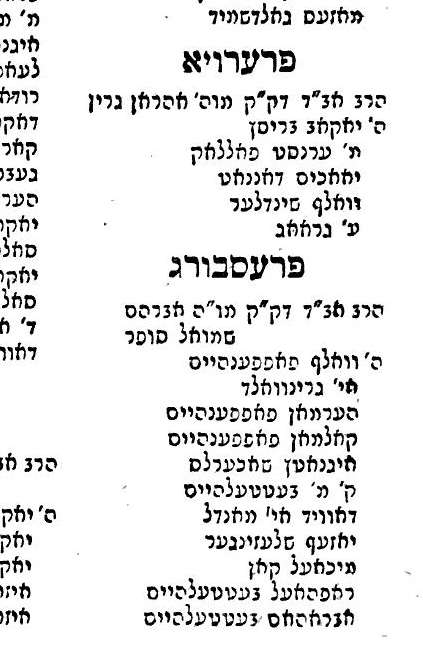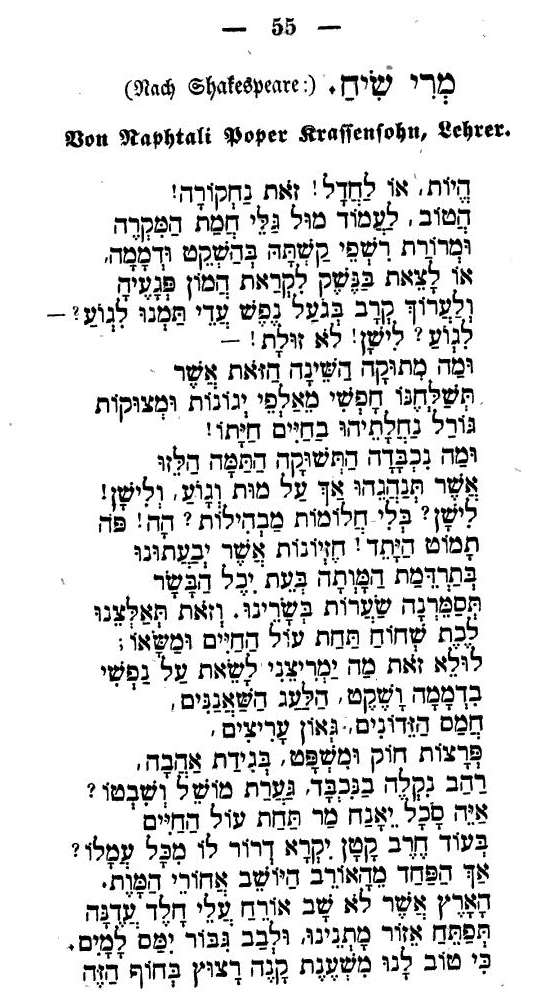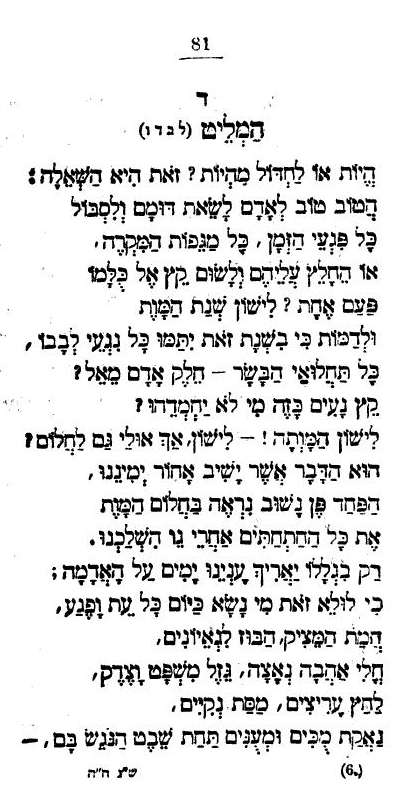The book is basically little musings about Truth, plus an essay about the 1826 shipwreck of the H.M.S. Frances Mary. As near as I can tell, this was written - much less included - because the author wanted to practice his Hebrew or translation skills.
Here's the title page of חקירת האמת:

The book includes an interesting and imaginative, but fanciful, guess that the reason why the English word for שקר is Falsehood is because it is a composite of the two words false and hood. This is a metaphor for what Falsehood is and does; it is not true and it "hoods" (covers) the truth. Of course "hood" is an English suffix as well as a word, and in its suffix form it means "state or condition of being," from O.E. -had "condition, position," cognate with Ger. -heit," etc.

It also contains what may well be the first Hebrew translation of Shakespeare's famous lines spoken by Hamlet, To be or not to be - that is the question! -

The biblically allusive אהיה את אשר אהיה, או אהיה אפס ואין: זאת אשאלה?י is not, in my opinion, the best possible translation. Strangely enough in the first edition the quote is להיות או לא להיות, הויה ואפס היא השאלה. Evidently he felt that אהיה את אשר אהיה improved it, which is an opinion not shared by me. I was able to find an excerpt from the first edition:

The book includes his subscription list. I'm sure most people reading this know what that means, but it's time to review. In those days a very popular method of raising funds necessary for printing a book was to get people to subscribe to it in advance. They'd give some money, and this would entitle them to a copy when the book was printed, and the names of these people were listed in the books, generally grouped by city of residence.
So here we see that one of the subscribers to this book is Rabbi Avraham Shmuel Sofer, the Kesav Sofer, son of the Chasam Sofer, of Pressburg. So if anyone ever tells you that there's no chance that the Kesav Sofer ever owned, much less ordered, a book which includes Hebrew translations of Shakespeare and essentially secular philosophical musings about the nature of emes and sheker, here is the evidence to the contrary:

It would be wrong not to include other translations of Hamlet's soliloquy, so here is another one from 1856 - perhaps the second such translation. This one is by someone named Naphtali Poper Krassensohn included in volume 22 of Mendel Stern's Kochebe Yitzchak with the title מרי שיח. It must be translated from German, whereas Brueck - who spent time in England - translated from English:


His translation of the famous To be line is היות, או לחדל! זאת נחקורה!י.
Finally, there is Yehuda Leib Gordon's translation, היות, או לחדול מהיות? זאת היא השאלה!י:






Worth noting - http://bdld.info/2010/09/14/the-baal-mussar-and-the-bard/
ReplyDeleteThis blog might not make sense. I'm still trying to make sense of it all. Just going on adventures, trying new things, meeting new people, being out, saying yes to everything, closing the gap between my thoughts and my actions.
ReplyDeleteThere is a Poppenheim who is the PR guy for the Eidah Hachareidis
ReplyDeleteThese translations remind me of the legendary Yiddish version of a Shakespeare play that was billed as "fartaitsht un farbessert" (translated and improved). This may not be a mere bubbe mayse; see http://mendele.commons.yale.edu/wp/2000/06/05/fertayched-und-farbessert-revisited/.
ReplyDeleteThe translation into Yeshivish has "to be, or chalila, fahkert."
ReplyDelete>There is a Poppenheim who is the PR guy for the Eidah Hachareidis
ReplyDeleteI know. Mistama he's descended from Kalman, not r"l Hermann.
IN the sefer VAYEHI BINSOAH by R. Grunfeld (a well known book dealer in BP and a gabbe at the Bobover rebbe) describing an early post War trip of the Bobover rebbe to Europe and Israel, the Rebbe and his companions find themselves in Venice on the way to Israel and the rebbe tells the chassidim about the Merchant of Venice and Shakespeare of course the chassidim do not know what he is talking about...
ReplyDeleteIts Pappenheim and the 2 most famous members of the family were Reb Wolf (not the one here) the Rosh hakahal of the Schiff Schul (and head of the Austian Aguda)in Vienna and Anna O of Freud fame whose name was Pappenheim too and came from this Orthodox family
ReplyDeleteI have always thought To be or not to be? an English translation of the debate whether tov loi leodom shloi nivro mishenivro.
ReplyDeleteTo be or not to be - Gam zu l'tova.
ReplyDeleteS, I suspect that "rashid" may be a spammer.
an
ReplyDeleteinteresting book called
an interesting book called
an interesting book called
it is very good